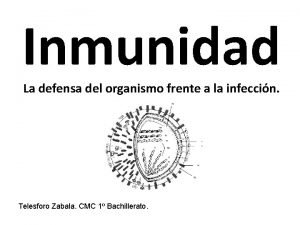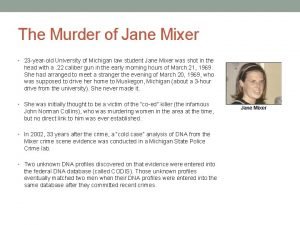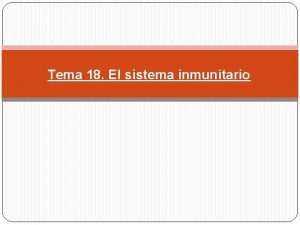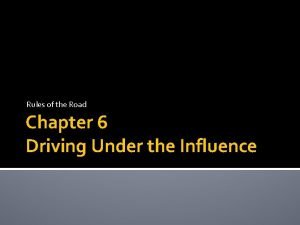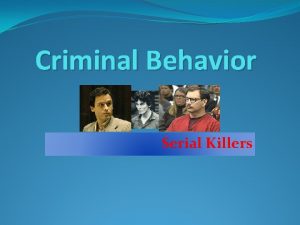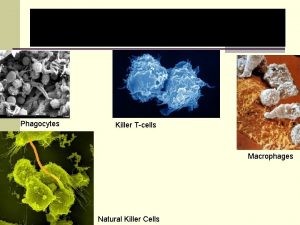Aim What is a serial killer What are

















































































- Slides: 81

Aim: What is a serial killer? What are some common characteristics of serial killers? DO NOW: Take out article on Psychopath vs Sociopath. HW: None

Interview with BTK Serial Killer What is your impression of the BTK killer? Sane or insane? • https: //www. youtube. com/watch? v=ZXa_Yre. EFEs

Symptoms of a Psychopath 1. 2. 3. 4. 5. Sociopath Appears normal Need for power/ control Low Autonomic Arousal Lacks Empathy

What is the difference between a serial killer and mass murderer? Serial Killer • murder three or more victims, but each is killed on separate occasions (over a period of weeks, months, years) • usually select their victims • cooling off periods between murders – there is a cycle (active to cooling off period) • plan their crimes carefully • Usually one on one killing. Killer is usually a stranger to victim • Rarely for profit (motive is psychological, sexual, aggressive, assert power through killing) • Victim may have symbolic value for killer Mass murderer • Kills several people in matter of hours at most • Usually take victims from one location Ex: Las Vegas, Charles Whitman University of Texas, Dylan Klebold and Eric Harris - Columbine

Who is a serial killer? TASK: • Look at the slides # 1 – 16 and decide which one you think is the serial killer. • What factors influenced your decision? • What are some stereotypes/assumptions we have about serial killers? https: //www. youtube. com/watch? v=H 3 Pf. VNODh_U

















Aim: What is a serial killer? What are the similarities and differences between psychopaths and sociopaths? DO NOW: Take out Sheet on Serial Killer Stereotype Study HW: Read Article “The Pro’s to being a Psychopath” w/ questions

Who is a serial killer? • What did you base your decision upon? • What are some stereotypes we have about serial killers? https: //www. youtube. com/watch? v=H 3 Pf. VNODh_U

Read 1 of the Articles and fill in the Venn diagram. Sociopath Psychopath

Aim: Is the protagonist from “Tell Tale Heart” a psychopathic serial killer? DO NOW: 1. Take out HW “Pro’s to being a psychopath” 2. Quick review – symptoms of psychopath? Homework: Write a 8 – 10 sentence answer to the aim using text evidence from todays lesson.

The Pro’s To Being a Psychopath 1. What are three traits positive traits exhibited by psychopaths according to the author? 2. How can each of these traits lead to potentially negative behaviors? 3. In your opinion do the rewards of being a psychopath outweigh the risks? Explain

Is the protagonist in “Tell Tale Heart” a psychopathic serial killer? Find examples from the story to illustrate evidence of…. 1. Sociopath 2. Appears normal 3. Need for power/ control 4. Low Autonomic Arousal 5. Lacks Empathy • https: //www. youtube. com/watch? v= envukur 1 q 3 I

Legal insanity in a nutshell The criminal can not… 1. Distinguish fantasy from reality 2. Tell right from wrong 3. Control his/her behavior And the actions are due to a mental defect.

Aim: Is the protagonist from “Tell Tale Heart” a psychopathic serial killer? What are some stereotypes about serial killers? DO NOW: Take out HW - What symptoms does he have of a psychopath? • Sociopath Appears normal • Need for power/ control • Low Autonomic Arousal • Lacks Empathy Homework: Serial Killer Myth Assignment

Protagonist SANE INSANE

Aim: What are some stereotypes/myths associated serial killers? - Wednesday DO NOW: Homework: Complete Serial Killer Myth Assignment – Choose 3 Myths to find 3 examples to support AND 1 to oppose.

Top Myths about Serial Killers 1. 2. 3. 4. 5. 6. 7. 8. 9. 10. Most serial killers operate alone. Most serial killers are white males. Most serial killers exhibit sexually deviant behaviors. Most serial killers travel and operate between different states (don’t stay in one area). Most serial killers cannot stop killing once they start (compulsive behavior). Most serial killers have one or more clearly diagnosable mental disorders. Most serial killers experience relief once they are caught. Most serial killers live with their mothers or grandmothers. Most serial killers play “cat and mouse games” (leave deliberate, taunting clues) with the police. Most serial killers keep souvenirs of their crimes. Task: Find 3 examples to support stereotype and one example to refute stereotype.

Profiling Serial Killers The Real Life Hannibal Lecters 1. 2. 3. 4. What are serial killers? What do they typically look like? Where do they live? Who are the majority of their victims? 5. What are usual practices towards their victims? 6. What causes them to behave the way they do? https: //www. youtube. com/watch? v=aseero 2 vj. C 0

Serial Killers • Most serial killers will fall into a pattern, either of modus operandi, location, victim type, motive, etc. • The patterns of activities often allow police to apprehend the killer. • Serial killers are often described as ‘normal’, ‘very chatty’ and ‘a good neighbor’. " We are your sons, and we are your husbands, and we grew up in regular families” Serial Killer Ted Bundy

Typical serial Killers are: • US has 76% of serial killers , Europe 2 nd w. 17% • Predominantly white male (73 % Caucasian /22% black) • Within their twenties or thirties • Middle class • Kill within their ethnic group • 65% of victims are females

What are some Characteristics of Serial Killers • • • Usually intelligent Good appearance Superficial charm Able to differentiate right from wrong Have no conscience Enjoy victim's terror Ted Bundy

Forensic Psychology • Application of methods, theories & concepts of psychology within the legal system. • Looks at impact of police officer, victim, juror, expert witness, lawyer, judge, defendant, prison guard &/or parole officer on the legal system.

What Forensic Psychology is NOT. Forensic Scientist v. Analyze, compare, identify & interpret physical evidence v. Identify evidence & link it to the suspect, victim & crime scene Forensic Psychiatrist v. Apply Psychiatry to the Law v. Expert witnesses in court v. Application of medical treatment in forensic settings

Aim: What are the different “types” of serial killers? -Thursday DO NOW: • Take out Serial Killer Stereotype Assignment. What are some examples of serial killers that do not meet the stereotypes? Homework: Analyze Case # 7 and classify the serial killer (organized/disorganized, type etc)

Holmes Typology p. 12 – 13 Differences Between Organized and Disorganized

Organized • Show signs of planning and evidence of control at the crime scene • Offenders are - • • • Intelligent Socially skilled/ charismatic Sexually competent Occupationally mobile Geographically mobile Live with a partner Follows media Usually target strangers Antisocial & psychopathic personality Harsh childhood discipline Interest in media Model inmate

Organized Serial Killers � Perpetrator plans the murder for months or years beforehand. � Offender is normally married, has steady employment, and is thought to be a good member of society (ex. , BTK -Dennis Rader) � They bring the instruments of the crime (knives, guns, tape) to the scene with them. �When Ted Bundy was pulled over for driving suspiciously (in 1975), police found an ice pick, ski mask, rope and handcuffs in his trunk. � These murderers are often highly intelligent and are knowledgeable about forensic evidence and law enforcement's investigative capabilities.

Disorganized • Unplanned and disorganized behavior & lack of control at the crime scene • Offenders are • Low intelligence • high school failure • Socially and sexually inept • Live alone/ seldom dates • Severe mental illness • Frightened or confused state of mind • • Likely have been suffered from physical or sexual abuse as a child unemployed father has secret hiding places Nocturnal lives/works near crime unskilled worker low interest in media high anxiety during crime

Disorganized Serial Killers • They do not plan their crimes in advance. • The disorganized murderer commits the crimes spontaneously. • They are often unemployed and without transportation. • They are more often of low intelligence or psychotic.

Types of Serial Killers Act Focused versus Process Focused page 6 - 7 • Visionary type: “visions” or “voices” guide their actions • Mission-orientated type – want to remove a certain group from society • Hedonistic type - derive pleasure or gain from the killing • Power/ control-orientated type - enjoy controlling their victims with some sexual satisfaction

Psychological Types of Serial Killers � Power Oriented – Ted Bundy and Dennis Rader enjoyed watching terror of their victims � Mission Oriented - killers feel they are improving the world by getting rid of undesirable people such as prostitutes, i. e. Green River Killer Gary Ridgway � Visionary - those who kill because they are directed by hallucinations, i. e. David Berkowitz - "Son of Sam"

Psychological Types of Serial Killers • Hedonistic - gain sexual satisfaction from raping, killing, mutilating, and sometimes eating the victim, i. e. Jeffrey Dahmer • Comfort - those who kill for financial gain, such as insurance benefits, real estate, i. e. Golay & Rutterschmidt • Disciple - those killers who kill under the influence of a charismatic killer, i. e. Leslie Van Houten and Lynette Fromme of the Manson family







Case Studies For EACH of the cases identify. . 1. Organized or disorganized 2. Psychological Motivations (Visionary, Mission Oriented, Hedonistic, Comfort, Disciple, Power Oriented)

Male versus Female Serial Killers Page 7 - 8

Aim: How are serial killers “made”? - Friday Do Now: • Take out Case Study # 7 and Debrief Disorganized - Unplanned and disorganized behavior & lack of control at the crime scene Organized - Show signs of planning and evidence of control at the crime scene HW: Notecard on Serial Killer with research notes to give a 30 – 60 second biography on the serial killer.


• Fill out a notecard for each of your highlighted killers, including basic biographical information and important details of their crimes. Tomorrow, you will give a one-minute or less summary of one of your killers (your choice). This will be a quick way to get the entire class up to speed on a large number of serial killers, making it easier for each person to make their choice for the larger research project.

Nova: Mind of a Rampage Killer 1. What was discovered about Whitman after her shot students at the UT Austin Campus? 2. How do the brains of killers differ from normal brains? 3. What can we learn from the interactions of rats with their mothers? 4. What role does attachment play in the development of killers? 5. Why are the brains of teens more susceptible to damage? https: //www. youtube. com/watch? v=H 4_-0 VECWd 0 CLICK VIDEO TO WATCH

Risk Assessment: How are criminals ‘made’? Research shows the role of the following in the : making” of a serial killer. • Genetics/DNA/chromosomes • Environmental factors • Biochemistry • Family traits • Economic circumstances • Neurological damage **A combination of these factors can be devastating

The Mind of a Serial Killer • https: //www. ted. com/talks/jim_fallon_exploring_the_mind_of_a_kill er

How are criminals made? Genetics • Criminals have a genetic predisposition • Genetic anomaly limits the function of the amygdala, leaving psychopaths with inability to understand & feel emotion • Studies show similar tendencies in twins raised apart • Extra chromosomes have been linked to some serial killers

How are criminals made? Biochemistry • Reduced glucose levels • Reduced seratonin levels (seratonin mellows us out) • Increased testosterone (creates need to dominate) • Sometimes have high traces of toxic metals

How are criminals made? Brain traits Psychopaths have abnormal brain activities: • Less active pre-frontal cortex (impulse control) • Overactive limbic system (aggression, sexual desire) • Overactive temporal lobes (temper outbursts and mood disturbances) Normal Murderer

How are criminals made? Neurological Damage • Frontal Lobe damage causes lack of social behavior and selfcontrol • Phineas Gage • Albert Fish (Brooklyn vampire) had frontal lobe damage at age 7

How are criminals made? Environmental Causes- Page 11 - 12 The roots of antisocial behavior lie in early childhood events: • insecure attachment • a weak sense of self • a dysfunctional family • coercive or indifferent parenting • physical, sexual or emotional abuse or neglect • the death of a parent • low family income • Separated or divorce • low academic achievement

Psychological Profiles of Serial Killers • A psychological profile is a submitted report utilizing information and approaches from various social and behavioral sciences, focusing on a specific type of violent crime • According to the FBI, a typical serial killer is a Caucasian male between the ages of 18 -32 who has been a victim of child abuse and who has exhibited signs of the Mc. Donald triad • Mc. Donald triad – bedwetting after the age of 12, setting fires, killing small animals

Psychological Profiles of Serial Killers – Mc. Donald Triad � Most serial killers exhibit at least one of these behaviors � According to Robert Ressler (FBI), more than 60% of serial killers wet the bed past the age of twelve � The Son of Sam, David Berkowitz, set 1, 412 fires but switched over to killing because it gave him more excitement and TV news coverage � Keith Jesperson, a serial killer from British Columbia who murdered more than 160 victims, started with dozens of cats and other small animals, before he moved on to human beings

Psychological Phases of Serial Killers • Aura • Trolling • Wooing • Capture • Murder • Totem • Depression

Appling Research on Serial Killers to Jeffery Dahmer 1. Is Dahmer Act Focused or Process Focused? (Identify What subtype as well)Why? EVIDENCE 2. What factors from his childhood contributed • https: //www. youtube. com/w atch? v=w 7 Bon. Oh. Sub. Y to his progression as a serial killer? 3. Using Holmes Typology would you say Dahmer is organized or disorganized? Why? • https: //www. youtube. com/w Apply the stages to the case study. Aura, atch? v=1 xus 91 WFbr 8 Trolling, Wooing, Capture, Murder, Totem, Depression 4. What psychological disorder do you think Dahmer had?

What is meant by “criminal behavior? Conditions resulting in criminal behavior include: • Antisocial personality disorder • Sociopathy • Psychopathy • Conduct Disorder • Borderline personality disorder

What are personality disorders? • Symptoms have been present for an extended period of time, are inflexible and pervasive, and are not a result of alcohol or drugs or another psychiatric disorder. • The symptoms have caused and continue to cause significant distress or negative consequences in different aspects of the person's life. • Symptoms are seen in at least two of the following areas: • Thoughts (ways of looking at the world, thinking about self or others, and interacting) • Emotions (appropriateness, intensity, and range of emotional functioning) • Interpersonal Functioning (relationships and interpersonal skills) • Impulse Control

Criminal Profiling What do psychologists base their profile on? How do they develop a “profile”? What do they look for at a crime scene? What is a M. O. ? What is a signature?

First Case of Profiling Dr. James Brussels • 1940 Bomb left at Con. Ed w/ Note that said “CON EDISON CROOKS. THIS IS FOR YOU” • 1 year later a similar device was found • 3 months later during WWII a typed note was sent to the police “ Iwill make no more bomb units for the duration of the war- my patriotic feelings have made me decide this – later I will bring Con Edison to justice – they will pay for their dastardly deeds” • 1950 3 rd unexploded bomb was found – FBI felt like it wasn’t meant to go off • 4 th found at NY Public Library and Grand Central Station • Over next 6 years 30 bomb planted and most were detonated You are Dr. Brussels, what would your profile be? (Who , What, Why etc)

Dr. Brussels Profile Male Former Employee of Con Ed, injured while working, seeking revenge Paranoid 50 years old Neat and meticulous Foreign background Wrote dastardly deeds and didn’t use contemporary slang Some formal education Believed he had Oedipal complex , phallic construction of bombs, wrots breats like W’s, a Unmarried when he would plant bombs in theatres he would slash/penetrate the seats Living with female relatives but no mother who probably dies when he was young • When he is found he will be wearing a buttoned up double breasted jacket • • • Explain the reasons for Dr. Brussels profile. What reasons are they based upon?

Modus Operandi � Object - kind of property taken, such as bras and panties � Time - time of day or night, weekdays, non-work days, holidays (when people would not miss the perpetrator at work) � Style - the description the criminal gives the victim to gain entrance (plumber, cable TV repairman) � Tale - any disclosure the criminal makes as to his business/purpose � Pals - any co-conspirators � Transport - what type of vehicle was used in connection with the crime � Trademark - any unusual act committed by the suspect while in the commission of the crime (i. e. poisoning the cat, eating at the scene after murdering the grandmother)

Difference Between Modus Operandi and Signature Two murderers both burn their victims by dousing them with gasoline. �The second murderer douses • The first murderer does so as the victim with gasoline to an anger-retaliatory act. cover up the crime. • This is a signature behavior. �This murderer does so to evade detection. �This therefore is a precautionary act, and as such is a modus operandi behavior.

Aim: What is a serial killer? What are the requirements for our project/case study? Do Now: 1. Take out your notecard and get ready to share with class. Homework:

Serial Killer Project: to explore one of the most bizarre and intriguing human behaviors, the serial killer. • Pick ONE serial killer from around the world and explain and analyze their behavior. • After you have selected your person 1. Research (See questions) 2. Write 3 Page Paper to answer those questions 3. Presentation Timeline – Research – Wed and Thurs Work On Paper - Tues 11/7 and Wed 11/8 Work on Presentation – Thurs. 11/9 and Mon. 11/13 Paper Due –Thurs. 11/9 Presentations Begin - Tues. 11/14

Research/Paper PART I: Biographical Information • General information about the killer you are researching and his/her life and upbringing, his/her crimes, and trial and sentencing. –SEE QUESTIONS - they are intended to be guidelines to aid your research. PART II: Criminal Activity • General information about the killer’s crimes, and his/her trial and sentencing. SEE QUESTIONS– they are intended to be guidelines to aid your research. PART III: Characterizing the Serial Killer • Determine which category the killer fits into and give specific examples to support your choice • Organized • Disorganized • Identify and explain the type of serial killer and provide examples to support your choice Part IV: Applying Psychological Perspectives • Choose TWO of the perspectives you believe best explains the persons development into a serial killer (psychodynamic, humanistic, behavioral, cognitive, biological) Upload to turnitin. com AND print out a copy for class

Presentation • Present info about serial killer – from research questions • Expand upon ideas, beyond just staring what is bulleted. Give evidence/ explanations from your research. • No fewer than 8 slides identifying each of the four parts (2 parts person at least!) from your paper. • 8 illustrations min. / 1 per slide at least • Works Cited slide at the end (this does not count as one of your 8 slides) • Bulleted points (no paragraphs). Try to keep it to 15 – 20 words per slide • 5 – 8 minutes • Include a video clip of no more than 1 minute.
 Types of killers
Types of killers Insidan region jh
Insidan region jh Serial killer triangle
Serial killer triangle Bt serial killer
Bt serial killer Bedwetting serial killers
Bedwetting serial killers Serial killer pierce
Serial killer pierce Lindsey serial killer
Lindsey serial killer Red spider serial killer
Red spider serial killer Bosnian serial killer
Bosnian serial killer What is the general profile for a serial killer
What is the general profile for a serial killer Psychology of serial killers
Psychology of serial killers Psicopatia e espiritismo
Psicopatia e espiritismo Alvaro bert montoya
Alvaro bert montoya Marybeth tinning husband
Marybeth tinning husband Thesis statement generator
Thesis statement generator Serial killer research paper
Serial killer research paper Serial killer jewelry
Serial killer jewelry Macdonald triad meaning
Macdonald triad meaning Thesis statement about serial killers
Thesis statement about serial killers Gallego serial killer
Gallego serial killer Serial killer trivia facts
Serial killer trivia facts Organized nonsocial offender
Organized nonsocial offender Scsi unit fbi
Scsi unit fbi Process focused serial killers
Process focused serial killers Crc error detection
Crc error detection Cereal book project
Cereal book project Serial killer project
Serial killer project Dramaserialsemi
Dramaserialsemi Parallel in serial out shift register
Parallel in serial out shift register Pink gorilla west seattle
Pink gorilla west seattle Jenny jones killer episode
Jenny jones killer episode Killer whale vocalizations
Killer whale vocalizations Inmunidad activa y pasiva diferencias
Inmunidad activa y pasiva diferencias Killer thesis statement
Killer thesis statement Randall woodfield
Randall woodfield Case of the killer robot
Case of the killer robot Michigan murders
Michigan murders Killer words of customer service
Killer words of customer service Green assassin weed killer
Green assassin weed killer Kavo killer 2020
Kavo killer 2020 Killer coke
Killer coke Chasing lincoln's killer lesson plans
Chasing lincoln's killer lesson plans Freedom leung
Freedom leung Killer whale communication
Killer whale communication Killer papers
Killer papers Hepatitis b
Hepatitis b Life 120 cosa mangiare
Life 120 cosa mangiare Killer pitch deck
Killer pitch deck Old tom the killer whale
Old tom the killer whale Highway patrol filming locations
Highway patrol filming locations Elizabeth 1 killer queen
Elizabeth 1 killer queen Kvik killer
Kvik killer Killer
Killer Tema 18
Tema 18 With whom do booth and herold stay at locust hill farm?
With whom do booth and herold stay at locust hill farm? Lonnie franklin jr
Lonnie franklin jr Chasing lincoln's killer chapter 4
Chasing lincoln's killer chapter 4 Young termite queen
Young termite queen John szyc
John szyc Robocode walls
Robocode walls Lonnie trumbull
Lonnie trumbull What model is it
What model is it Paul snyder killer
Paul snyder killer John sosnovske obituary
John sosnovske obituary Killer whale eating sea lion
Killer whale eating sea lion Btk killer
Btk killer Herr killer uni passau
Herr killer uni passau Bryan calvin hartnell
Bryan calvin hartnell Killer queen time signature
Killer queen time signature Why is alcohol the #1 killer on american roadways?
Why is alcohol the #1 killer on american roadways? Célula natural killer
Célula natural killer Qqqv
Qqqv Ebm
Ebm Aim road maintenance
Aim road maintenance The great aim of education is not knowledge
The great aim of education is not knowledge Spot welding temperature
Spot welding temperature Goals for clinical supervision
Goals for clinical supervision Aim slang
Aim slang Definition of health psychology
Definition of health psychology Aimcest
Aimcest Aim for success
Aim for success Aim of manual handling
Aim of manual handling
































